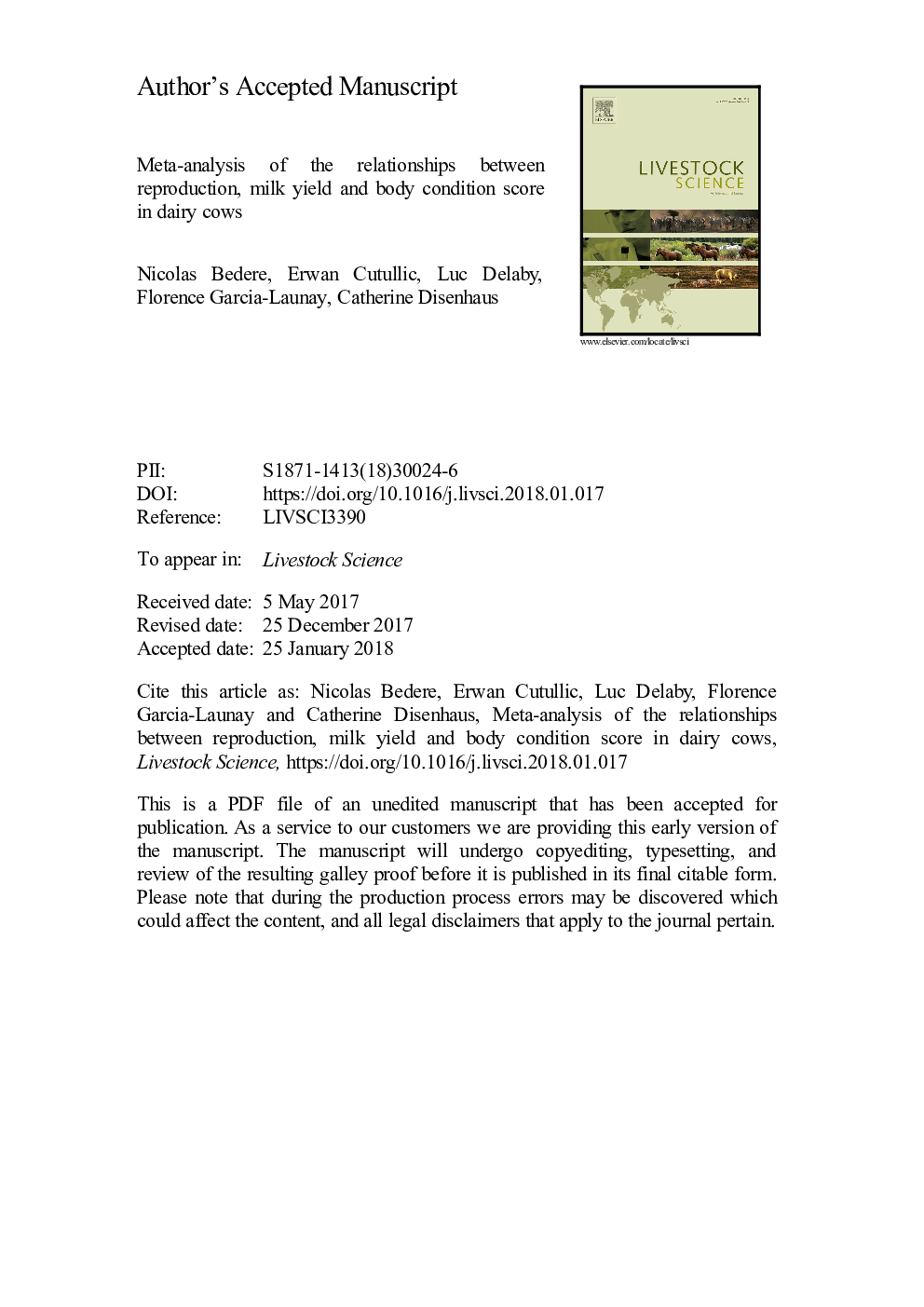| کد مقاله | کد نشریه | سال انتشار | مقاله انگلیسی | نسخه تمام متن |
|---|---|---|---|---|
| 8502018 | 1553922 | 2018 | 35 صفحه PDF | دانلود رایگان |
عنوان انگلیسی مقاله ISI
Meta-analysis of the relationships between reproduction, milk yield and body condition score in dairy cows
ترجمه فارسی عنوان
متاآنالیز رابطه بین تولید مثل، تولید شیر و نمره وضعیت بدن در گاوهای شیری
دانلود مقاله + سفارش ترجمه
دانلود مقاله ISI انگلیسی
رایگان برای ایرانیان
کلمات کلیدی
موضوعات مرتبط
علوم زیستی و بیوفناوری
علوم کشاورزی و بیولوژیک
علوم دامی و جانورشناسی
چکیده انگلیسی
The present study aimed to investigate the relationships between each step of the reproductive process (cyclicity, estrus, and fertility) and both milk production and body reserves management. The database included 102 studies and 300 treatments collected on electronic databases. Coding for each type of experimental factor enabled within and between experiment variation to be distinguished, and to select subsets of experiments with common objectives in order to avoid inappropriate aggregation of results across studies with very different objectives. Finally, the models were based on limited numbers of experiments (from 14 to 30 treatments originating from 7 to 15 distinct experiments) because (i) only data coded for diet and genetic factors were analyzed, separately (studies on other factors such as milking frequency and parity were too scarce); (ii) a minimum of variation of the explanatory variable was set to enable the quantification of the relationship; (iii) few studies reported comparable reproductive, production and body reserves traits. The results of the meta-analyses showed that the commencement of luteal activity (C-LA) was not associated with milk yield and that the relationship between C-LA and body condition score (BCS) at calving was quadratic (with an optimal BCS at calving around 3.10 on a 0-5 scale). Although the interval from calving to first observed estrus (COE1) is partly composed of C-LA, it was not associated with BCS. For each additional 1â¯kg of milk yield produced at both peak and over the initial 14 weeks of lactation, COE1 was delayed by 1.1 days. The conception rate to first insemination (CRAI1) was reduced by 2.0% (of inseminated cows) and by 2.2% for each additional 1â¯kg of milk yield at peak and at service respectively. Moreover, CRAI1 was increased by 38.2% and 22.0% for each additional 1 score of BCS at service and at nadir (i.e. lowest BCS) respectively. Finally, risk of pregnancy (PR) was not associated with milk yield. However, PR was increased by 42.8% (of cows) and 16.8% for each additional unit of BCS at calving and at nadir, respectively. This meta-analysis showed that postpartum cyclicity of dairy cows was mainly associated with BCS at calving, whereas estrus expression was mainly associated with milk yield and fertility with both BCS and milk yield. Genetic and nutritional strategies that target a BCS of 3.10 and limit both BCS loss and peak milk yield could be an effective way to improve reproduction.
ناشر
Database: Elsevier - ScienceDirect (ساینس دایرکت)
Journal: Livestock Science - Volume 210, April 2018, Pages 73-84
Journal: Livestock Science - Volume 210, April 2018, Pages 73-84
نویسندگان
Nicolas Bedere, Erwan Cutullic, Luc Delaby, Florence Garcia-Launay, Catherine Disenhaus,
